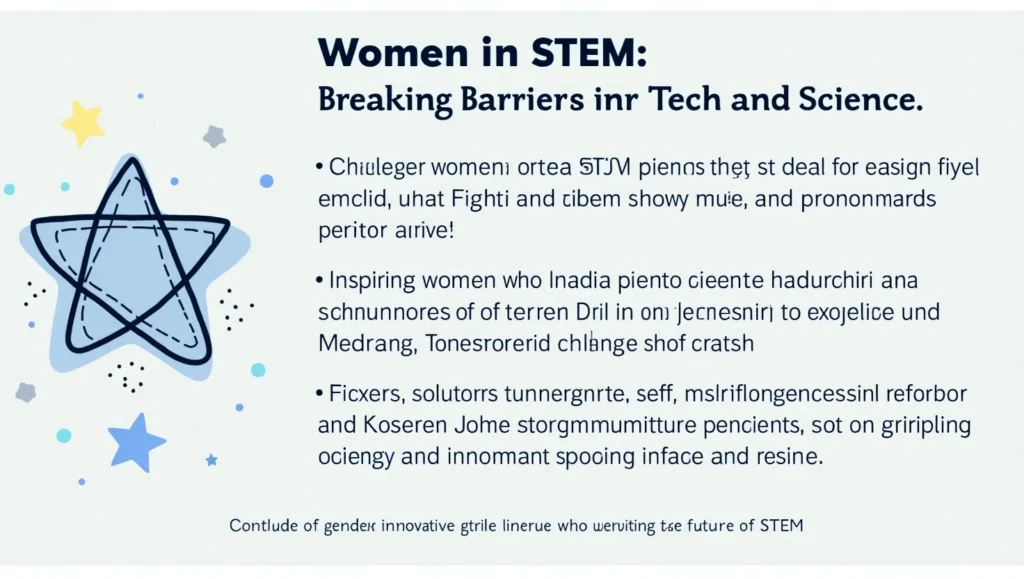Breaking Barriers in Tech and Science
For decades, women have been making significant contributions to science, technology, engineering, and mathematics (STEM), yet they have faced numerous barriers in these male-dominated fields. Breaking Barriers in Tech and Science Today, women continue to break stereotypes, challenge gender biases, and pave the way for future generations. Their determination, innovation, and resilience are transforming industries and reshaping the future of STEM.
The Gender Gap in STEM
Despite advancements in gender equality, women remain underrepresented in many STEM fields. Breaking Barriers in Tech and Science According to global studies, women make up a smaller percentage of professionals in areas like engineering, physics, and computer science compared to fields like biology and medicine.
Challenges Faced by Women in STEM
- Gender Bias and Stereotypes: Women in STEM often encounter biases that question their abilities or leadership skills.
- Lack of Representation: With fewer female role models in STEM, aspiring women may feel discouraged from pursuing careers in these fields.
- Workplace Discrimination: Unequal pay, limited opportunities for promotions, and workplace harassment are significant hurdles.
- Work-Life Balance Challenges: The demand for long hours in STEM careers can make it challenging for women to balance work and family responsibilities.
Women Who Have Made History in STEM
Despite these obstacles, many women have defied expectations and made groundbreaking contributions in STEM. Here are some of the most influential women who have paved the way:
1. Marie Curie (Physics & Chemistry)
- The first woman to win a Nobel Prize and the only person to win in two different sciences (Physics and Chemistry).
- Her research on radioactivity laid the foundation for medical treatments and nuclear science.
2. Ada Lovelace (Computer Science)
- Recognized as the first computer programmer for her work on Charles Babbage’s Analytical Engine.
- Her vision of machines performing more than calculations led to the development of modern computing.
3. Katherine Johnson (Mathematics & Space Science)
- A NASA mathematician whose calculations were critical to early U.S. space missions, including Apollo 11’s moon landing.
- Overcame racial and gender barriers to become one of NASA’s most respected mathematicians.
4. Rosalind Franklin (Biochemistry & DNA Research)
- Played a crucial role in discovering the double-helix structure of DNA through her X-ray diffraction images. Breaking Barriers in Tech and Science
- Despite being overlooked during her lifetime, her contributions remain vital to genetics and medicine.
5. Dr. Fei-Fei Li (Artificial Intelligence)
- A leading AI researcher and advocate for ethical AI development.
- Pioneered ImageNet, a dataset that revolutionized deep learning and computer vision.
Encouraging More Women in STEM
Breaking barriers for women in STEM requires collective effort from governments, organizations, educational institutions, and society as a whole. Here are some strategies to encourage more women to enter and thrive in STEM careers:
1. Early STEM Education and Encouragement
- Schools should introduce STEM subjects at an early age and promote hands-on learning experiences. Breaking Barriers in Tech and Science
- Encouraging girls to participate in science fairs, coding bootcamps, and engineering projects can build confidence.
2. Representation and Role Models
- Highlighting successful women in STEM through media, mentorship programs, and industry conferences inspires young girls to pursue these fields.
- More women in leadership roles in STEM can break the cycle of underrepresentation.
3. Supportive Workplace Policies
- Equal pay, maternity leave, and family-friendly policies can help retain more women in STEM careers.
- Organizations should establish mentorship programs and professional development opportunities for women.
4. Addressing Gender Bias and Discrimination
- Creating inclusive work environments, offering unconscious bias training, and promoting diverse hiring practices can help eliminate discrimination.
- Encouraging women to speak up and report bias or harassment ensures a safer workplace. Breaking Barriers in Tech and Science
Final Thoughts
With continued efforts, the landscape of STEM is evolving. More women are entering and excelling in STEM careers, leading innovations in artificial intelligence, space exploration, biotechnology, and engineering. Breaking Barriers in Tech and Science Organizations worldwide are recognizing the importance of diversity in driving scientific and technological advancements.
Women in STEM are not just breaking barriers; they are shaping the future. By supporting, empowering, and advocating for gender equality in STEM fields, we can create a more inclusive and innovative world for generations to come.

